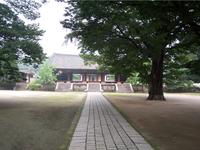You are in: Asia -> Korea, Democratic People's Republic of -> Historic Monuments a... , and traditional search or Image Gallery will yield results of this site only
Historic Monuments and Sites in Kaesong
| Site number: | 1278 |
|
| Type of site: | Cultural | |
| Date: | 10-14 centuries | |
| Date of Inscription: | 2013 | |
| Location: | Asia, Korea (Democratic People's Republic), Kaesong | |
Up to 75 images are shown here. Click on each for more details or on Image Gallery for more images.
Six official UN languages:
Arabic,
Chinese,
English,
French,
Russian,
Spanish
Other languages: Belarusian, Bulgarian, Czech, Danish, Dutch, Estonian, Finnish, German, Indonesian, Italian, Japanese, Korean, Lithuanian, Mongolian, Norwegian-bokmål, Norwegian-nynorsk, Polish, Romanian, Scots, Slovenian, Swedish, Thai, Ukrainian, Vietnamese
Other languages: Belarusian, Bulgarian, Czech, Danish, Dutch, Estonian, Finnish, German, Indonesian, Italian, Japanese, Korean, Lithuanian, Mongolian, Norwegian-bokmål, Norwegian-nynorsk, Polish, Romanian, Scots, Slovenian, Swedish, Thai, Ukrainian, Vietnamese
| Description: | Situated in Kaesong city, in the south of the country, the site consists of 12 separate components, which together testify to the history and culture of the Koryo Dynasty from the 10th to 14th centuries. The geomantic layout of the former capital city of Kaesong, its palaces, institutions and tomb complex, defensive walls and gates embody the political, cultural, philosophical and spiritual values of a crucial era in the region’s history. The monuments inscribed also include an astronomical and meteorological observatory, two schools (including one dedicated to educating national officials) and commemorative steles. The site testifies to the transition from Buddhism to neo-Confucianism in East Asia and to the assimilation of the cultural spiritual and political values of the states that existed prior to Korea’s unification under the Koryo Dynasty. The integration of Buddhist, Confucian, Taoist and geomantic concepts is manifest in the planning of the site and the architecture of its monuments. --WHMNet's description is from WHC Site, where additional information is available. | |
| Kaesŏng (Gaeseong; Korean pronunciation: [kɛsɔŋ]) is a city in North Hwanghae Province, southern North Korea (DPRK), a former Directly Governed City, and the capital of Korea during the Koryo Dynasty. The city is near Kaesŏng Industrial Region close to the border with South Korea and contains the remains of the Manwoldae palace. Called Songdo while it was the ancient capital of Koryo, the city prospered as a trade center that produced Korean ginseng. Kaesŏng now functions as the DPRK's light industry centre. Due to the city's proximity to the border with South Korea, Kaesŏng hosts cross-border economic exchanges between the two countries as well as a jointly-run light industrial center in the Kaesŏng Industrial Region, which the New York Times has called "the last symbol of inter-Korean cooperation" given recent political tensions between the two nations. However, on March 30, 2013, the DPRK's Korean Central News Agency, KCNA, announced that the North Korean government intended to close the center, and on April 3, 2013, North Korea began denying South Korean workers access to the center. On April 8, 2013, the North Korean Government announced it would remove all approximately 53,000 North Korean workers from the industrial park, which effectively shut down all activities. As of 2008, the city had a population of 308,440. --Wikipedia. Text is available under the Creative Commons Attribution-ShareAlike License. | ||
| Source: | http://whc.unesco.org/en/list/1278 | |
| Source2: | Wikipedia (http://wikipedia.com) | |
| Reference: | 1. UNESCO World Heritage Center (http://whc.unesco.org/en/list/1278). 2. Wikipedia. | |













